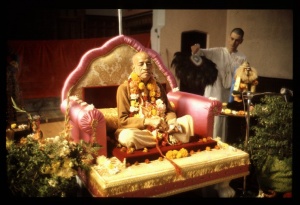SB 3.28.26

A.C. Bhaktivedanta Swami Prabhupada
TEXT 26
- vakṣo 'dhivāsam ṛṣabhasya mahā-vibhūteḥ
- puṁsāṁ mano-nayana-nirvṛtim ādadhānam
- kaṇṭhaṁ ca kaustubha-maṇer adhibhūṣaṇārthaṁ
- kuryān manasy akhila-loka-namaskṛtasya
SYNONYMS
vakṣaḥ — the chest; adhivāsam — the abode; ṛṣabhasya — of the Supreme Personality of Godhead; mahā-vibhūteḥ — of Mahā-Lakṣmī; puṁsām — of persons; manaḥ — to the mind; nayana — to the eyes; nirvṛtim — transcendental pleasure; ādadhānam — bestowing; kaṇṭham — the neck; ca — also; kaustubha-maṇeḥ — of the Kaustubha gem; adhibhūṣaṇa-artham — which enhances the beauty; kuryāt — he should meditate on; manasi — in the mind; akhila-loka — by the entire universe; namaskṛtasya — who is adored.
TRANSLATION
The yogī should then meditate on the chest of the Supreme Personality of Godhead, the abode of goddess Mahā-Lakṣmī. The Lord's chest is the source of all transcendental pleasure for the mind and full satisfaction for the eyes. The yogī should then imprint on his mind the neck of the Personality of Godhead, who is adored by the entire universe. The neck of the Lord serves to enhance the beauty of the Kaustubha gem, which hangs on His chest.
PURPORT
In the Upaniṣads it is said that the various energies of the Lord are working to create, destroy and maintain. These inconceivable varieties of energy are stored in the bosom of the Lord. As people generally say, God is all-powerful. That prowess is represented by Mahā-Lakṣmī, the reservoir of all energies, who is situated on the bosom of the transcendental form of the Lord. The yogī who can meditate perfectly on that spot on the transcendental form of the Lord can derive many material powers, which comprise the eight perfections of the yoga system.
It is stated herein that the beauty of the neck of the Lord enhances the beauty of the Kaustubha gem rather than vice versa. The gem itself becomes more beautiful because it is situated on the neck of the Lord. A yogī is therefore recommended to meditate upon the Lord's neck. The Lord's transcendental form can either be meditated upon in the mind or placed in a temple in the form of a statue and decorated in such a way that everyone can contemplate it. Temple worship, therefore, is meant for persons who are not so advanced that they can meditate upon the form of the Lord. There is no difference between constantly visiting the temple and directly seeing the transcendental form of the Lord; they are of equal value. The advantageous position of the yogī is that he can sit anywhere in a solitary place and meditate upon the form of the Lord. A less advanced person, however, has to go to the temple, and as long as he does not go to the temple he is unable to see the form of the Lord. Either by hearing, seeing or meditating, the objective is the transcendental form of the Lord; there is no question of voidness or impersonalism. The Lord can bestow the blessings of transcendental pleasure upon either the visitor of the temple, the meditator-yogī or one who hears about the Lord's transcendental form from scriptures like the Śrīmad-Bhāgavatam or Bhagavad-gītā. There are nine processes for executing devotional service, of which smaraṇam, or meditation, is one. Yogīs take advantage of the process of smaraṇam, whereas bhakti-yogīs take special advantage of the process of hearing and chanting.